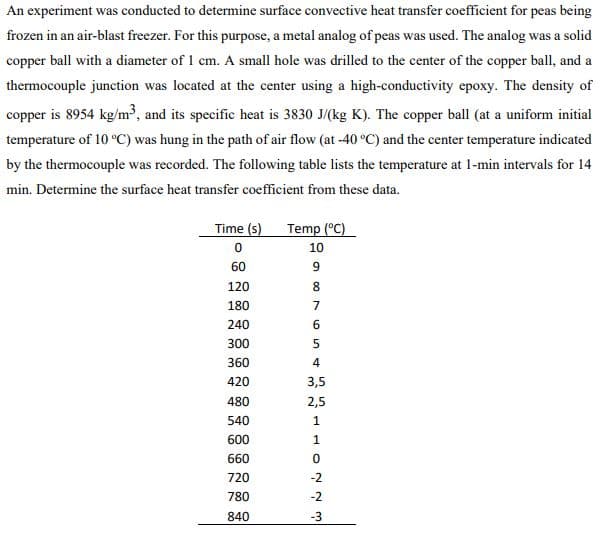An experiment was conducted to determine surface convective heat transfer coefficient for peas being frozen in an air-blast freezer. For this purpose, a metal analog of peas was used. The analog was a solid copper ball with a diameter of 1 cm. A small hole was drilled to the center of the copper ball, and a thermocouple junction was located at the center using a high-conductivity epoxy. The density of copper is 8954 kg/m³, and its specific heat is 3830 J/(kg K). The copper ball (at a uniform initial temperature of 10 ºC) was hung in the path of air flow (at -40 °C) and the center temperature indicated by the thermocouple was recorded. The following table lists the temperature at 1-min intervals for 14 min. Determine the surface heat transfer coefficient from these data.
An experiment was conducted to determine surface convective heat transfer coefficient for peas being frozen in an air-blast freezer. For this purpose, a metal analog of peas was used. The analog was a solid copper ball with a diameter of 1 cm. A small hole was drilled to the center of the copper ball, and a thermocouple junction was located at the center using a high-conductivity epoxy. The density of copper is 8954 kg/m³, and its specific heat is 3830 J/(kg K). The copper ball (at a uniform initial temperature of 10 ºC) was hung in the path of air flow (at -40 °C) and the center temperature indicated by the thermocouple was recorded. The following table lists the temperature at 1-min intervals for 14 min. Determine the surface heat transfer coefficient from these data.
Principles of Heat Transfer (Activate Learning with these NEW titles from Engineering!)
8th Edition
ISBN:9781305387102
Author:Kreith, Frank; Manglik, Raj M.
Publisher:Kreith, Frank; Manglik, Raj M.
Chapter9: Heat Transfer With Phase Change
Section: Chapter Questions
Problem 9.15P
Related questions
Question

Transcribed Image Text:An experiment was conducted to determine surface convective heat transfer coefficient for peas being
frozen in an air-blast freezer. For this purpose, a metal analog of peas was used. The analog was a solid
copper ball with a diameter of 1 cm. A small hole was drilled to the center of the copper ball, and a
thermocouple junction was located at the center using a high-conductivity epoxy. The density of
copper is 8954 kg/m³, and its specific heat is 3830 J/(kg K). The copper ball (at a uniform initial
temperature of 10 °C) was hung in the path of air flow (at -40 °C) and the center temperature indicated
by the thermocouple was recorded. The following table lists the temperature at 1-min intervals for 14
min. Determine the surface heat transfer coefficient from these data.
Time (s)
0
60
120
180
240
300
360
420
480
540
600
660
720
780
840
Temp (°C)
10
9
8
7
6
5
4
3,5
2,5
1
1
0
-2
-2
-3
Expert Solution
This question has been solved!
Explore an expertly crafted, step-by-step solution for a thorough understanding of key concepts.
This is a popular solution!
Trending now
This is a popular solution!
Step by step
Solved in 3 steps with 9 images

Knowledge Booster
Learn more about
Need a deep-dive on the concept behind this application? Look no further. Learn more about this topic, mechanical-engineering and related others by exploring similar questions and additional content below.Recommended textbooks for you

Principles of Heat Transfer (Activate Learning wi…
Mechanical Engineering
ISBN:
9781305387102
Author:
Kreith, Frank; Manglik, Raj M.
Publisher:
Cengage Learning

Principles of Heat Transfer (Activate Learning wi…
Mechanical Engineering
ISBN:
9781305387102
Author:
Kreith, Frank; Manglik, Raj M.
Publisher:
Cengage Learning